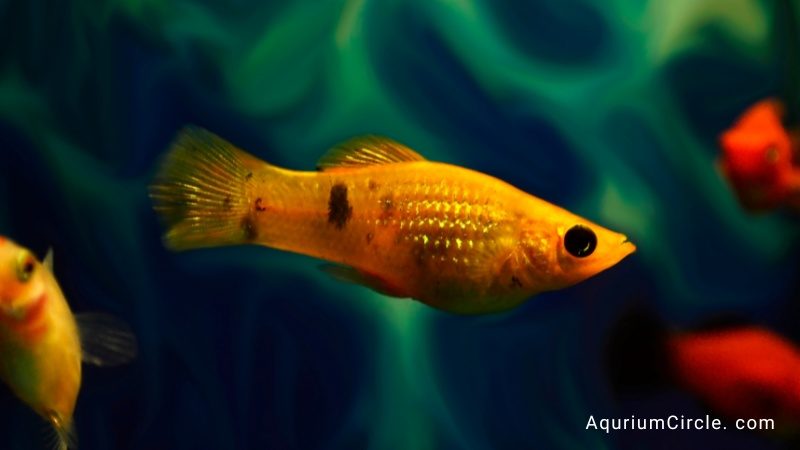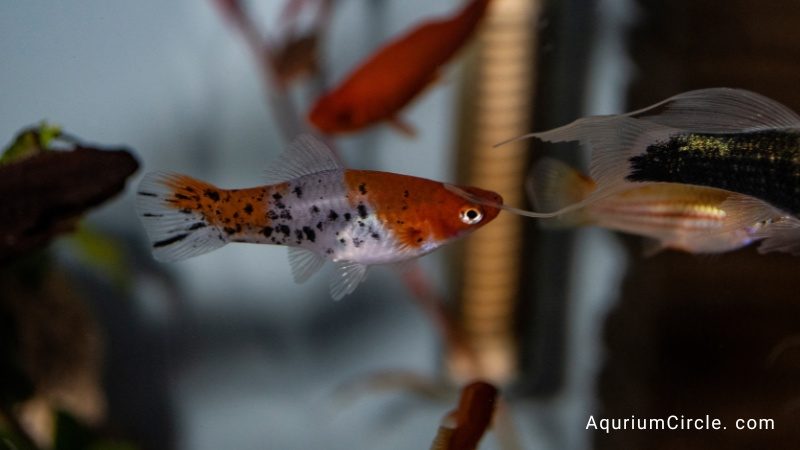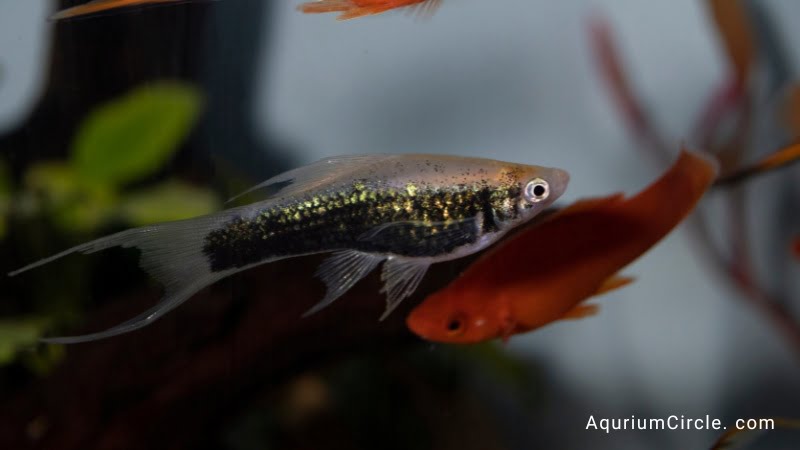The Molly and Swordtail Fish is one of the most beautiful and weird-looking fish in the world. It is a member of the livebearer fishes and can be found in both fresh and saltwater habitats. This popular fish is not only beautiful, but it also has some pretty cool features that make it an interesting pet choice. In this ultimate Molly Swordtail Fish guide, we will discuss its characteristics and how to allow them to breed.
What Is Swordtail Molly?
That’s the short name of a fish that combination of Swordtail fish and Molly fish. The Swordtail FIsh is a popular freshwater fish species that belongs to the family Poeciliidae. It is native to Central America and is widely distributed throughout North America, South America, and the Caribbean. Swordtail Fish are characterized by their distinctive elongated tail fin, which is often longer in males and resembles a sword.
The body of the Swordtail Fish is usually a silver or pale yellow color with black speckles or stripes. They are hardy, peaceful, and easy to care for, making them a popular choice for beginner fish keepers. Additionally, they are known to be livebearers, meaning they give birth to live young instead of laying eggs.
Can A Molly And A Swordtail Breed?
No. they can’t cross-breed. People have different perspectives and experiences when it comes to breeding molly and swordtails, and they share their own stories. Most people think that these two species are incapable of interbreeding; serious problems might arise if they did. Below are a few reasons why this is the case.
Different families
They belong to different families, so it is impossible to interbreed because of their different age groups and genetic factors. They both produce live young, yet fish mollies are Poecilia, and swordtails are Xiphophorus. Crossbreeding is not permitted outside of their families as a general rule.
Mollies who get impregnated by swordtails can die
A significant reason is that interbreeding of these species usually results in fatal outcomes. A study has found out that a female molly will most likely die after being impregnated by a swordtail. Therefore, it concludes that they are incompatible, so you should avoid breeding them together.
Breeding incompatibles
As some people have noticed, they got a gravid spot while they were a couple in the aquarium. It is one of the reasons people believe they can interbreed. However, we would like to point out that both mollies and swordtails can store sperm in their bodies for quite a long time, and they can subsequently become pregnant using sperm from the original partner.
Mollies and swordtails are unable to interbreed, as you can see. You can choose which species to raise in the tank by reading the next part of this article.
Swordtail Or Molly – Differences

If you’re looking for a fish that is neither too big nor too small, the swordtail might be a good choice. This fish has an average length of six to eight inches and can weigh up to four pounds. Swordtails have a triangular-shaped bodies with sharp, pointed fins on each side.
On the other hand, Molly fish are more rounded and have smaller fins. In addition, they’re slightly larger than swordtails, measuring an average of nine inches long and weighing two to three pounds. The main difference between swordtails and mollies is their color – the mollies are usually light brown or gold, while the swordtail’s fins are typically dark blue or green.
Swordtail molly male or female
There are a few differences between male and female Swordtail Mollies that are visible once they reach maturity. Here are some of the main differences:
- Size: Male Swordtail Mollies are generally smaller in size than females, with slimmer bodies.
- Anal fin: The anal fin of a male Swordtail Molly is modified into a gonopodium, which is a specialized structure used for fertilizing the female’s eggs during mating. Female Swordtail Mollies do not have this structure.
- Tail fin: The tail fin of a male Swordtail Molly is generally longer and more pointed than that of a female.
- Coloration: In some Swordtail Molly varieties, males may have brighter or more vibrant coloration than females.
It is worth noting that these differences may not be obvious until the fish reach maturity, which typically occurs around 3-4 months of age.
Comparison of Molly Swordtail Fish Breeding Processes
Each individual’s breeding process has certain similarities and peculiarities. As a result, we’d want to go through these procedures in great depth so that you can comprehend them better.
Similarity
Mollies and swordtails, as previously said, are livebearer fish, which means that their progeny develops inside before giving birth to fry fish. Female mollies with internal fertilization can have eggs within after mating and keep them there until fry mollies are ready.
Both individuals have a similar inseminate schedule, with offspring appearing around one month after the egg is fertilized. Mollies and swordtails are waiting for their fry to become self-sufficient and live on their own at this time.
Female swordtails and mollies have another trait: they can store sperm for a long period and fertilize eggs without the presence of a male swordtail in the tank.
In both cases, the mating process is straightforward, and you are not required to intervene. You will notice when the male fish goes under the female and copulation begins. They will generally exhibit comparable pregnancy signs, such as hiding at the bottom of the tank and refusing to feed. Their larger abdomen will also be visible.
You must create a nice fish tank environment for your pregnant mollies and swordtails, adding required shelters and hiding plants. It is also beneficial to keep the water warm, as they feel calmer this way.
Difference

When it comes to the age, there is a significant disparity between the two groups. In general, females become fertile around 6 months, whereas males might take up to a year, depending on the species of molly being studied. In contrast, swordtails do not require as much time, and they are generally ready to reproduce when they reach the age of three months (or less).
Unlike mollies, swordtails frequently consume their newborn offspring. Make sure your swordtails are properly nourished before giving birth and transfer the fry to another tank to avoid this happening to them. In addition, you may add some attractive plants and create hiding spots for the fried chicken. It takes around 2 months for young swordtails to grow and can be kept in captivity with adult swordtails.
Some Other Fish Species
There are some rare swordtails if you want to know more.
Kohaku swordtail
The Kohaku Swordtail is a color variation of the Swordtail Molly that is highly sought after by fish keepers due to its striking and unique appearance. This variety of Swordtail Molly is characterized by its bright red-orange coloration with white patches, which are reminiscent of the traditional Japanese koi fish pattern.
Interestingly, the Kohaku Swordtail was not selectively nurtured by humans, but instead arose spontaneously in a breeding population of Swordtail Mollies. Despite its popularity, the Kohaku Swordtail is relatively rare in the wild, and most specimens available in the aquarium trade are captive-bred. This makes it a special addition to any aquarium, and a testament to the beauty and diversity of the natural world.
Blood red swordtail
The Blood Red Swordtail is a striking and colorful variation of the Swordtail Molly that is highly prized by fishkeepers for its unique appearance. It is characterized by its deep red coloration, which covers the entire body of the fish, from head to tail.
It’s interesting that the Blood Red Swordtail, which has only been selectively bred in captivity since the late 1990s, is a relatively recent addition to the aquarium trade. In comparison to other Swordtail Molly strains, which have been selectively cultivated for a lot longer, this makes it a relatively fresh variation. The Blood Red Swordtail is an excellent choice for both novice and seasoned aquarists because it is a calm and simple-to-care-for fish.
Koi molly
A vibrant kind of swordtail molly known as Koi Molly is distinguished by its design that mimics the well-known Koi fish. Selective breeding has produced this distinctive appearance, which can include a mix of black, white, orange, and red scales.
It’s interesting to note that whereas Koi fish can live up to 25–30 years in the wild, Koi Molly only lives for about 3–5 years on average. Yet, this makes it a fantastic alternative for aquarium hobbyists who wish to retain a colorful and attractive fish without the commitment required to keep Koi fish. Koi Molly is a durable and low-maintenance fish, which makes it a wonderful option for novices or those searching for a fish that is simple to take care of.
FAQs
Can platy breed with swordtails?
No, platy cannot breed with swordtails. While both platys and swordtails belong to the same family of fish, they are two different species that cannot interbreed with each other. However, it is possible for different species within the same family to interbreed, such as swordtails and mollies. But platys and swordtails cannot breed with each other as they have different genetic makeups and reproductive systems.
What is the molly fish breeding age?
Molly fish reach sexual maturity at around 3-4 months of age. This means that they can start breeding at this age, although it is not recommended to breed them until they are fully grown and have reached their adult size, which is usually around 6 months of age. It is also important to ensure that the breeding environment is suitable and that the fish are healthy before attempting to breed them.
How long swordtail’s lifespan?
On average, swordtails have a lifespan of 3 to 5 years, although some can live up to 7 years with proper care and a suitable environment. The lifespan of swordtails can vary depending on factors such as their genetics, diet, water quality, and overall care. Providing them with a well-maintained aquarium, appropriate diet, and regular health checks can help to ensure that they live long and healthy life.
References:
- Molly fish – https://www.theaquariumwiki.com/wiki/Poecilia_sphenops
- Mollies – https://freshwaterfish.fandom.com/wiki/Mollies
- Swordtail – https://en.wiktionary.org/wiki/swordtail

Annette M. Chaney is an experienced marine biologist with over 20 years of experience as an aquarist and fishkeeper. She started her first aquarium at a young age, filling it with frogs and goldfish obtained from the ten-cent pet store.
Annette grew up caring for and breeding African Cichlids, which led to a hobby in high school that doubled as a profitable means. Attending Reed College gave her time to solidify herself as an accomplished aquarium caretaker with an eye for sales. After that, from 2009 – 2013, she studied at Roger Williams University – one of the most prestigious universities for Aquaculture and Aquarium in USA. She is the founder of AquariumCircle since 2010.
